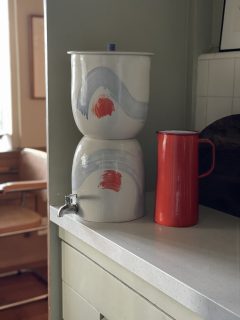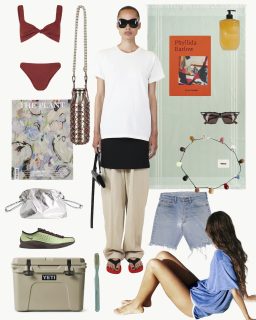A Useful Recommendation With Ambra Medda
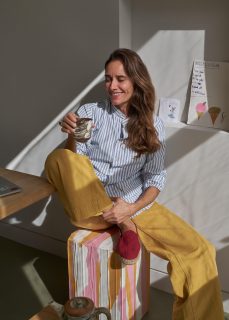
by Maisie Skidmore
Ambra Medda has led a storied career in the world of design – cementing, over its duration, a love of beautiful and practical everyday objects. Among them is her favourite one-cup coffee maker by Alessi, with its curved shape, highly functional mechanism, and pleasing pour.
Ambra, her husband and their two young daughters have recently relocated from London to Milan, where drinking coffee is akin to a spiritual practice. But it’s not without its obstacles, she explains – among them, finding the right pot, whether you are making coffee for six, for two, or simply for yourself.
In the Alessi 9090 Espresso Coffee Maker, a characterful one-cup creation, she has found a solution. Its creator, Richard Sapper, designed the 9090 to distill the technical features usually reserved for larger receptacles. So not only is it a charming shape, but it has an enlarged base to maximise heat conduction, an anti-drip spout, and a lever lock allowing the user to open the pot in a deft and simple gesture.
Once the coffee is drunk, Ambra’s day-to-day life is occupied by AMO. She is a cultural connector by trade. Through her design consultancy, she cultivates opportunities and connections between brands, cultural institutions, makers and designers around the world. Meanwhile in AMO Shop, Ambra and her team run a thoughtfully curated online store commissioning meaningful and responsibly produced objects, from furniture and textiles, to homeware and fashion.
This June, AMO presented Weaving Anni Albers at 3daysofdesign in Copenhagen, in collaboration with Italian textile editor Dedar, reinterpreting five of the artist’s original and groundbreaking designs.
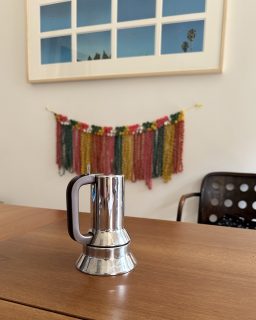
Ambra, tell us about your useful recommendation.
My husband and I drink coffee together in the morning from a big coffee pot, but then when he travels, which is actually quite a lot, I end up not making coffee – the pot’s too big, then I throw the coffee away, and then I feel bad. I told him, so he sweetly bought me this one. It’s just so perfectly designed. Look how tiny it is! It looks wonderful, it works well, and it’s just for one person, so it solves the problem. It does have to stay out all day, basically, because you wash it and then you can’t really reassemble it unless it’s really dry. So I end up spending a lot of time just having this sort of on display, and it’s unbeatable. A great design object, pure satisfaction. The whole ritual of coffee gives us a lot of pleasure.
What are you looking for in an object for the home?
The things I use that elevate my life are the objects that play a ceremonial role. They become part of a day-to-day ritual. For example, I drink Depuravita Ayurvedic tea all day, especially when I’m working from home, and I get a lot of pleasure out of that. It’s really gentle, and it just feels really good. We just did a show called Radical Hope, Positive Action, and we actually took the title for it from this teapot, which was made by Simon Bayliss, a potter in Cornwall who we love a lot. His father is an activist, so a lot of his work incorporates slogans. Because of the wording, you almost feel like you’re being nourished by these ideas. Given the times we’re living in, I think drinking a bit of positive action is doing me some good.
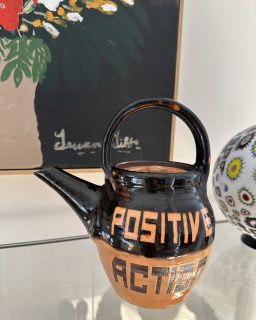
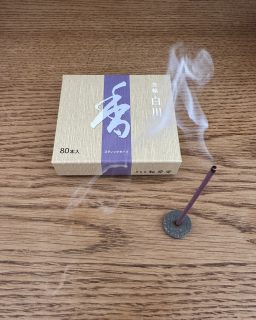
Do you have any other favourite rituals?
When I come home and tidy up the kitchen, or when I close my laptop, I’ll light an incense to change the mood. My favourite is Shoyeido’s Horin Shirakawa incense, this one is called White River. I’ve tried so many different kinds, and this has the most magical intensity – not too much, but also not too light. There’s a blue flavour, a red, a violet, and the names are fantastic. There’s also a little incense holder inside. And I have to show you this: when you get a new package, you take the plastic off, rip the paper at the side, and the next stick just slides out. It looks like I’m doing a magic trick!
Maisie Skidmore is a writer, editorial director, and commissioning editor at Phaidon. Her work explores fashion, art, design, and their intersection in contemporary culture. @maisieskidmore

